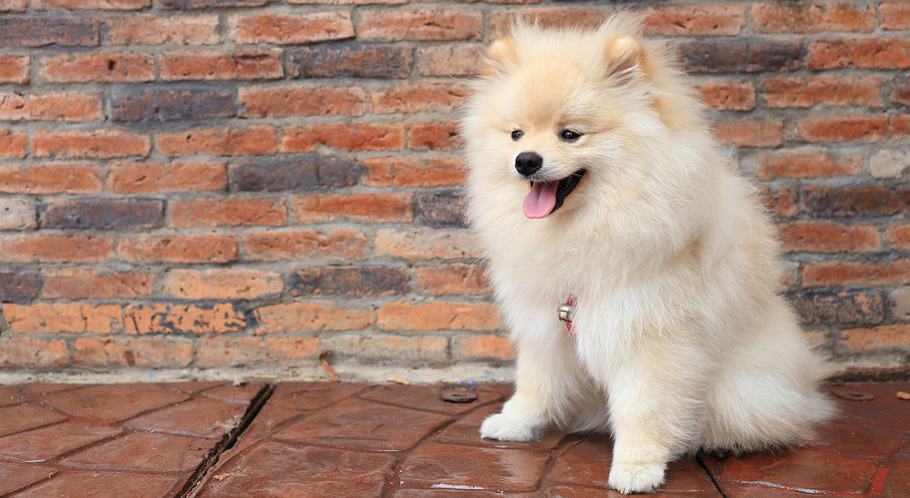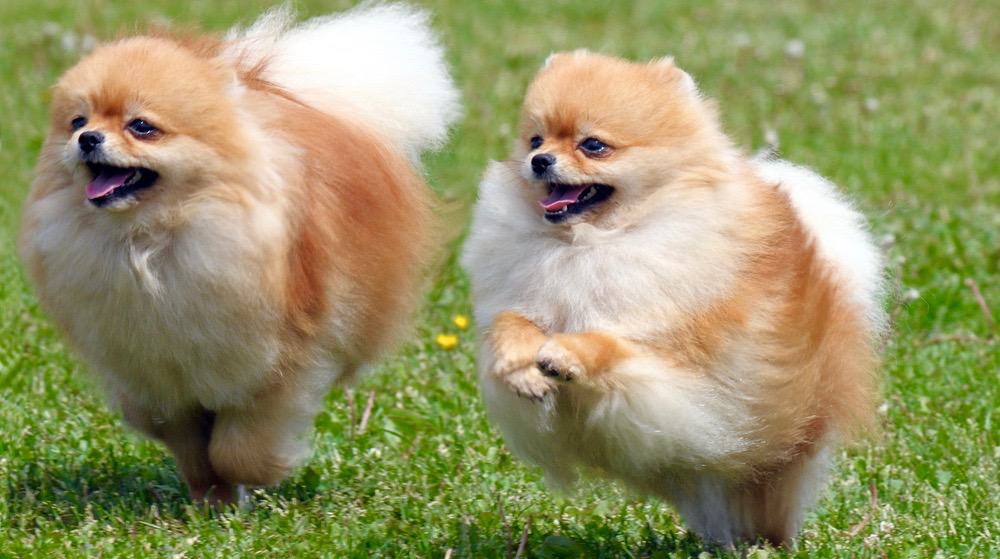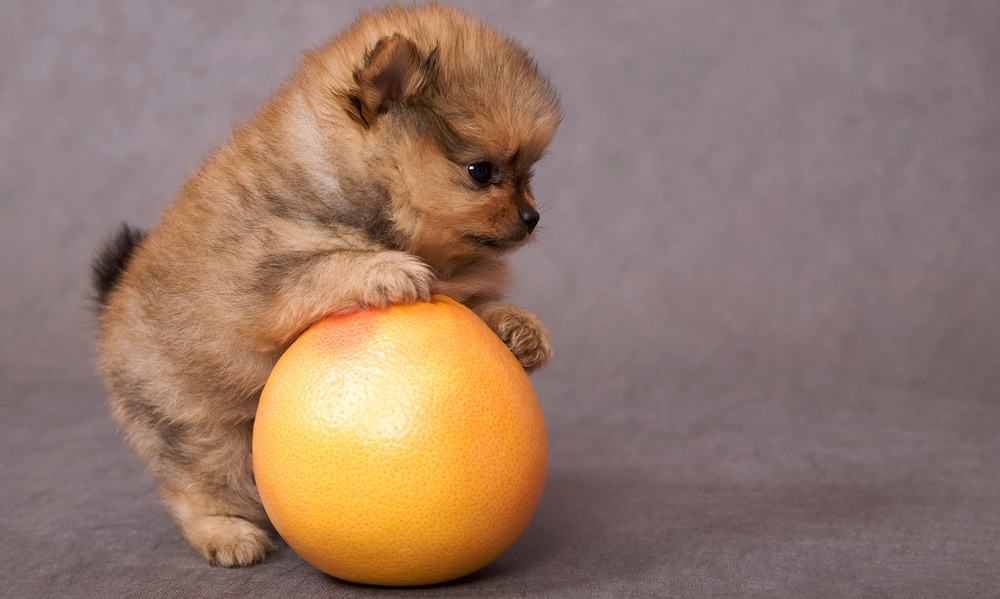Pomeranian Growth Chart – Weight & Size Chart
If you recently adopted a Pomeranian puppy, you may be wondering how much they will weigh when they are adults?
A Pomeranian growth chart will give you information on their height and weight through the different growth stages of their life.
As adults, Pomeranians stand at 6 to 7 inches and weigh between 3 and 7 pounds. The adult size of Pomeranians can be affected by certain factors such as genetics, nutrition, and physical activity.
This article will give you more information on what to expect as your Pomeranian grows, the number of puppies they have, and many more!
When Do Pomeranians Stop Growing?

Pomeranians normally stop growing after 12 months.
The majority of the growth for young Pomeranians occurs during the 2 to 12 month period. For some Poms, growth may continue into the 14 or 15-month period, however, this growth tends to be confined only to the chest size as opposed to overall growth.
There are a vast array of factors that can affect the growth of a Pomeranian. Factors can include environment (home), diet, exercise, and genetics.
Aside from genetics, 3 of these 4 factors can be controlled by the dog owner who should take note of how crucial the first 12 months of support can be to ensure the Pom grows to its full potential.
Pomeranian Size Chart
To help you fully understand the expected growth trajectory of the Pomeranian, the Pomeranian growth chart will be explained to give you specific information on what growth and weight should be expected from your Pom at each crucial stage of their life.
The chart will explain how you can estimate your Pomeranian’s weight and size. As a dog owner, keeping a close on your Pom’s weight and growth is a responsibility you should take seriously.
One of the earliest signs of illness or disease can be identified by stunted growth or extensive and sudden weight gain/loss.
The Pomeranian size chart breaks down the exact weights to expect across 5 different stages of a Pom’s development.
Adulthood is classed from 18 months and older, this is to account for late-stage growth that can occur from the 12 to 18 month period.
Considering the life expectancy of a Pomeranian is the region of 12 to 16 years, of which approximately 1 year is assigned to growing, it is important to use the Pomeranian weight chart closely in the Pom’s first year to ensure a long and healthy life.
Pomeranian Weight Chart
| Birth | 2.5 oz | 2.75 oz | 3 oz | 3.5 oz | 4 oz | 4.25 oz | 4.5 oz | 5 oz | 5.5 oz |
|---|---|---|---|---|---|---|---|---|---|
| 1 week | 4,5 | 5 | 5,5 | 6 | 7 | 7,5 | 8 | 9 | 9,5 |
| 2 weeks | 6 | 6,5 | 7 | 8,5 | 10 | 11 | 12 | 13 | 13,5 |
| 3 weeks | 7 | 8 | 8,5 | 10,5 | 13 | 14 | 15 | 16 | 17,5 |
| 4 weeks | 8 | 9,5 | 10 | 12 | 14,5 | 16 | 18 | 20 | 21 |
| 5 weeks | 9 | 11 | 11,5 | 13,5 | 16 | 18 | 20 | 22 | 24 |
| 6 weeks | 10 | 12,5 | 13 | 15 | 17,5 | 20 | 23 | 24 | 27 |
| 7 weeks | 11 | 12 | 14,5 | 17 | 19 | 22 | 25 | 27 | 30 |
| 8 weeks | 12 | 13,5 | 16 | 19 | 21,5 | 24 | 27 | 29 | 32 |
| 9 weeks | 13 | 15 | 18 | 22 | 23 | 26 | 30 | 33 | 35 |
| 10 weeks | 14 | 16 | 20 | 24 | 25 | 28 | 33 | 36 | 38 |
| 11 weeks | 15 | 17 | 21 | 26 | 28 | 31 | 36 | 39 | 42 |
| 12 weeks | 16 | 18 | 22 | 28 | 32 | 35 | 40 | 43 | 45 |
| 13 weeks | 17 | 20 | 24 | 30 | 34 | 36 | 42 | 45 | 48 |
| 14 weeks | 18 | 22 | 26 | 32 | 36 | 39 | 44 | 47 | 51 |
| 15 weeks | 19 | 23 | 28 | 34 | 38 | 42 | 46 | 51 | 55 |
| 16 weeks | 20 | 25 | 30 | 36 | 40 | 44 | 49 | 54 | 59 |
| 17 weeks | 21 | 26 | 31 | 38 | 42 | 46 | 51 | 57 | 62 |
| 18 weeks | 22 | 28 | 33 | 39 | 44 | 48 | 54 | 60 | 65 |
| 19 weeks | 23 | 29 | 34 | 40 | 45 | 50 | 56 | 62 | 67 |
| 20 weeks | 24 | 30 | 35 | 41 | 46 | 52 | 58 | 64 | 70 |
| 21 weeks | 25 | 31 | 36 | 42 | 48 | 54 | 60 | 66 | 72 |
| 22 weeks | 25 | 32 | 37 | 43 | 48 | 56 | 62 | 68 | 74 |
| 23 weeks | 26 | 33 | 38 | 44 | 50 | 57 | 64 | 70 | 76 |
| 24 weeks | 26 | 33 | 39 | 45 | 51 | 58 | 65 | 71 | 78 |
| 25 weeks | 27 | 34 | 40 | 46 | 52 | 59 | 66 | 72 | 79 |
| 26 weeks | 27 | 34 | 40 | 47 | 53 | 60 | 67 | 73 | 80 |
| Final Adult Weight | 2 lb | 2.5 lb | 3 lb | 3.5 lb | 4 lb | 4.5 lb | 5 lb | 5.5 lb | 6 lb |
Pomeranian Growth Chart – What To Expect

Birth – 2 Weeks
Pomeranian birth weights can vary from 2.5 oz to 5.5 oz. The first step is to know the starting weight and track it from there.
The expected weight gain from birth to 2 weeks is also dependent on the birth weight—however, the expected growth is typically a 140% to 145% increase from the birth weight after 2 weeks—certainly a fast pace!
Therefore, if your Pom was born 2.5 oz, the expected weight after 2 weeks would be 6 oz.
3 Weeks – 12 Weeks

The 3-week to 12-week period is a crucial stage in the Pom’s development. It is during this period that genetically larger Poms will gain a significant amount of weight, far exceeding genetically smaller Pom’s.
For example, a Pom born at 5.5 oz would be expected to gain 27.5 oz during this period (17.5 oz at 3 weeks to 45 oz at 12 weeks), while smaller Pomeranians can be expected to only reach a 12-week weight of 16 oz.
4 Months – 9 Months
During the 4-month to 9-month period, the Pom would be expected to have grown around 80% to 85% of its total body weight. It is at this stage where the puppy starts to resemble a fully grown Pomeranian.
Depending on the birth weight, the weights of Pomeranian’s after 9 months can vary from 27 oz to 80 oz.
Remember, always track from the birth weight of your Pom so that you have an accurate picture of your Pom’s overall health.
10 Months – 18 Months

The weight gain expected between the 10 month to 18 month period is should be fairly minimal—around 10% to 15% of their overall weight.
As previously mentioned, most Pom’s stop growing at 12 months, but all will certainly have gained their full weight by 18 months.
As your Pom should resemble an adult by 10 months, identifying weight gain can be slightly more difficult. Keep weighing your Pom regularly to ensure healthy growth is being maintained.
Adult
After 18 months, the Pomeranian has reached its adult weight. This weight can vary between 2 lb to 6 lb, depending on the size at birth and genetics.
After taking the 18-month weight, owners should regularly monitor the weight of their adult Pomeranian as routine health checks. Sudden weight gain or weight loss can be a sign of poor health, poor diet, or lack of exercise.
The goal should be to maintain their 18-month weight throughout adulthood, allowing for small fluctuations.
How Big Do Pomeranians Get?

The best way to determine how big your Pomeranian will get is to look at their mother and father. The weight and height of your puppy’s parents will give you a good idea of the adult size of your Pomeranian.
Let your breeder give you this information if you do not have access to the parents.
You can also look at your Pomeranian’s paws. If they appear unusually large than their legs and body, they are likely still growing. You can also request a DNA test from your vet to find out the size of your puppy’s relatives as adults.
As adults, Pomeranians weigh between 3 to 7 pounds with a height of around 6 to 7 inches.
Will Neutering/Spaying Affect My Pomeranian’s Growth?
Spaying is the removal of the ovaries and uterus of a female dog through surgery. This procedure prevents pregnancy and reduces the risk of ovarian cancer. Neutering involves the removal of testes in a male dog through surgery.
It makes male dogs infertile thus preventing breeding. Neutering is also known to reduce aggressive behavior and the risk of testicular cancer.
Spaying or neutering should be done when your Pomeranian is between the ages of four and nine months.
If done, too early and growth and development of your puppy can be affected because growth hormones depend on reproductive hormones.
Pomeranian Height Chart
The following are the steps you can follow to measure the height of your Pomeranian at home.
- Attach a white paper to a door frame or wall.
- Let your puppy stand straight alongside the door frame or wall.
- Feel your puppy’s withers, found at the base of the neck between the shoulder blades. Ensure that your puppy’s front feet are positioned directly underneath the blades.
- Put a ruler on the withers and to the paper while keeping it parallel to the ground.
- On the paper, draw a line where the ruler meets it.
- Measure from the ground to the mark and this is your Pomeranian’s height.
On average, the height of Pomeranians is between 6 and 7 inches.
How To Properly Weigh And Measure A Pomeranian?

The reason for weighing your Pomeranian is to calculate their daily caloric intake and to determine whether their weight is healthy or not.
Vets recommend that you weigh your Pomeranian every six months or even once per year. However, you should weigh them more regularly if they are undergoing treatments.
To weigh your Pomeranian, hold them with both arms and step on the scale for a few seconds. Check the number and record it. Gently drop your puppy on the ground and step on the scale.
Check the weight and write it down. Deduct your weight from the total weight of your puppy and you. This is your Pomeranian weight.
Spitz vs Pomeranian Size
Spitz and Pomeranians are similar but different in size. German Spitz is bigger compared to the Pomeranian.
On average, the weight of a German Spitz is between 18 and 29 pounds and stands at a height of around 12 to 15 inches.
On the other hand, Pomeranians weigh between 3 to 7 pounds and stand at a height of between 6 and 7 inches.
Pomeranian’s Neck Size?
Have you recently gotten a Pomeranian and what to buy them a collar? Or are you wondering how their neck size compares to other breeds? Measuring your Pomeranian’s neck will ensure that the collar you get them fits securely and comfortably.
Use a flexible measuring tape to determine the neck size of your Pomeranian. Hold the starting end of the tape in one hand, then use the other to circle it around the neck of your Pomeranian.
Put two fingers inside the measured area to ensure that the measurements will not lead to a tight collar.
On average, the neck size of a Pomeranian is between 10 and 14 inches.
Pomeranian Body Shape Changes

The body shape of Pomeranian changes as most would expect when growing from a puppy to an adult.
One of the most noticeable changes is that the Pom becomes much leaner when transitioning to adulthood.
This is aided by added height and width, particularly across the chest, which sees the chubby puppy become a tougher, more stable adult Pom. But to know you have a healthy adult Pom is best indicated by the furry balls of fluff running around your home.
As Pomeranians enter their senior years from the age of 8, it is not uncommon to see them reduce in body size. That is not to say that they become a puppy again, but they will slightly shrink compared to their peak adult years.
Factors That Affect Pomeranian Puppy Growth

Genetics
The factor most affecting the growth of a Pomeranian puppy is the genetics inherited from ancestors. Often owners may not be fully aware of the lineage of their Pom pup, but if possible, you should get hold of this information.
Seeing the size and weight of the parents and grandparents will be a good indicator as to the expected size of your Pom. This would reduce chances of concern should your Pom’s weight be on the extremes on either end of the scale.
Nutrition
Healthy, balanced nutrition is key to any prosperous, long and enriching life – it is no different for Pomeranians.
To support strong puppy growth, provide foods that are high in natural ingredients and are high-quality foods. Cheap, unhealthy, or incompatible foods can likely stunt the growth of your Pom.
The same rules apply to adulthood. Pom’s need energy from naturally sourced proteins and vitamins to live their characteristically energetic lives. Feed your Pomeranian well and the reward will be a long, healthy, and active life for your Pom.
Physical Activity & Health
Pomeranians are active, energetic dogs requiring regular exercise to keep stimulated. Regular intense exercise also strengthens the immune system to fight off any illnesses or diseases so is additionally important for the long-term health of your Pom.
Exercise can also strengthen the muscles and respiratory system of your Pom.
Whether it be walks twice a day or ball games, get your Pom outdoors and active to give them a long and healthy existence.
How Long Are Pomeranian Pregnant?
The gestation period for a Pomeranian is 63 days from the time of conception. This is no different from the majority of dog breeds.

The Pomeranians usually start breeding from the age of 2 up until age 5 to 7. Across a female Pom’s life, breeders would expect around 4 litters.
Although Pomeranians are ready to conceive from 8 months, waiting until 2 years old before starting the breeding is recommended as females are sufficiently mature to be mothers and go through the breeding process.
Poms should be of the correct weight, age and health before breeding to ensure a healthy litter is created.
How Many Puppies Do Pomeranians Have?
A typical Pomeranian litter will have between 1 and 4 puppies. Considering that Pomeranians could have a maximum of 4 litters over their lifetime, one female Pom could give birth to 16 Pom puppies—that’s a great effort!
After giving birth, your Pom could have small bleeding a discharge for around 10 days. However, if the Pom is a high temperature, smells bad, has excessive bleeding, or has no appetite, you must call the vet to ensure the Pom can be given proper care after the stress of giving birth.
What If My Pomeranian Is Not The Right Weight
Your Pomeranian could be the wrong weight due to either environmental, genetic, nutrition, or dietary reasons.
As previously discussed, finding out the genetic history of your Pom should be your first focus. If your Pom’s parents or grandparents were particularly lightweight or overweight, this could be a sign that your Pom is simply following the genetic make-up of their ancestors.
However, if genetics are fine, the other 3 controllable factors affecting your Pom’s weight could be the issue.

You should first consult your vet before making any dramatic dietary or exercise changes, but these changes can often be the cause of weight issues and can be easily fixed.
Whether it be transitioning to be a more rigorous exercise regime or providing higher quality, natural foods, you will likely see a quick change in the weight of your dog provided they have no other underlying health conditions.
What Is The Life Expectancy Of A Pomeranian?
Pomeranians are expected to live between 12 to 16 years. The core adult years are between 18 months to 8 years, with senior Pom’s showing signs of age from 9 onwards.
As Poms are a smaller-sized breed, they are on the higher end of the life expectancy scale compared to medium-sized and larger-sized dogs. This is great for owners who want a long-lasting family friend to keep them company.
Although the dynamism and energy slowly reduce as your Pom ages, investing in a Pom is an investment in an energetic ball of fluff!
How Much Does It Cost To Own A Pomeranian?

Buying a Pomeranian from a reputable breeder typically costs in the region of $600 to $1700. If you are looking for a specialty Pom breed, you can be expected to pay in the region of $3000.
The first couple of years of a Pom’s life are more high maintenance, therefore requiring a higher annual sum of around $1200 to cover all necessary maintenance costs. For those wanting external dog training, your costs will be higher than that.
Once your Pom enters adulthood, the total cost of feeding and maintaining a Pom is around $800 per year.
Pomeranian Genetics And Common Health Problems
The Pomeranian is a long-living dog breed with very few health problems specifically associated with the breed. However, there are few conditions to look out for.
Firstly, obesity. As the Pomeranian is a small dog breed, they do not require much food to have the sufficient energy required to last the day. As owners, you have to be very wary of portion sizes when feeding a Pom as they can very easily gain weight.
Another common issue with Pomeranians relates to dental health. As Poms have small mouths compared to the number of teeth, they can frequently suffer from gum and teeth issues as well as plaque build-up.
If plaque build-up is not sorted soon, it can lead to more serious mouth disease. To ensure your Pom has good dental health, brush their teeth regularly.









